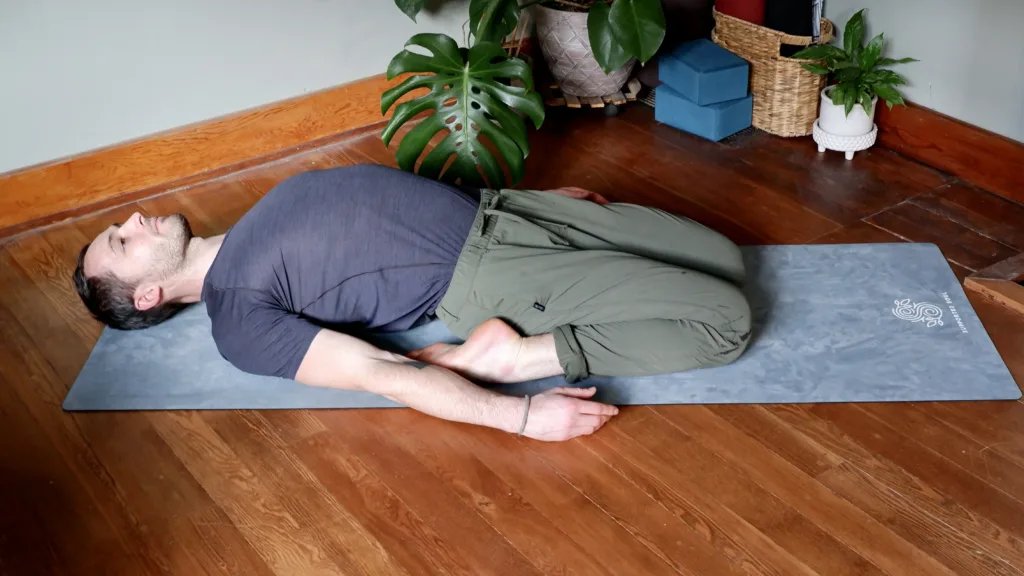
Ski season is fast approaching, it’s mere days until many resorts open so getting those legs ready is probably underway for you. Remember the burn in the quads that first day on the resort?
To help you with your goals we thought we’d share our favourite five yoga asanas that can help build strong, flexible and resilient legs. There are no weights needed and you can do them anywhere, even at the top of Glacier chair. They can be used as a warm-up in a sequence of flows, a cool down after a long hard day in the powder or before bed as a way to prepare your body for restful sleep. We’ve included additional information about the theory, philosophy and history of the poses too so you can add a bit more context and deepen your understanding of yoga, if you wish.
You might be wondering what’s so special about yoga for athletic performance. Although the following poses can exist outside the yogic system as ‘just exercises’, how they are executed and how they bring about bodily awareness when framed within the yoga context makes them significantly more effective. Rather than speedily cranking out reps on squat machines, yoga asanas allow us to slow down and develop a deep understanding of body mechanics. We take our time, we feel into the pose, we slow our breath and take a mindful approach to what is going on in the mind and body simultaneously. This can cultivate a deeper connection to your body and can increase spatial awareness, balance, stability and a ton of strength, both inner and outer. When we practice yoga we learn to control our breath so that we can stay calm under pressure, breathing deep and slow reminds us to be present as our attention is drawn out of thinking. That way we can appreciate the experience of being alive. Yoga practice also promotes mindfulness and one recent study found that athletes using a mindfulness training program “with two 30-minute practice sessions per week positively affected the participating athletes’ endurance performance and cognitive functions, including executive functions, in addition to increasing the efficiency of conflict resolution in neural processes”. PMID: 32908483.
Although it has recently been shown in various studies that stretching before exercise doesn’t necessarily improve performance or decrease the risk of injury it has been shown, however, that regular stretching practices as part of a holistic routine may decrease injury and increase performance due to a wider range of motion, the lengthening of skeletal muscle and fascia and increased flow to muscle tissue (PMID: 20086352). Therefore being consistent with practice can have great benefits to your performance. We recommend 1-2 yoga asana practices a week with additional maintenance stretching or other mobility work 2-3 times per week.
Utthan pristhasana serves as a preliminary posture for advanced hip-opening poses. The term originates from Sanskrit, with “utthan” translating to “stretch out,” “pristha” signifying “page of a book” or “back of the body,” and “asana” representing “pose.”
Utthan pristhasana enhances hip flexibility by stretching and opening the hips, while also providing a stretch for the hamstrings and quadriceps. Additionally, it strengthens both the inner thighs and leg muscles.
On a mental level, practicing this asana brings about a calming effect on the mind, provides stress relief, and facilitates the release of deeply rooted emotions.






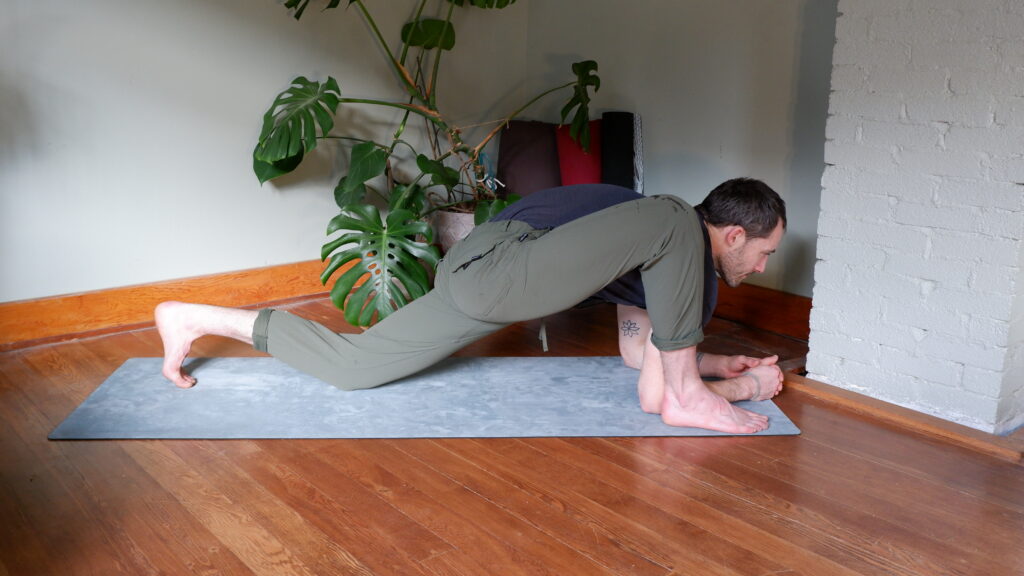


Begin in the Downward-Facing Dog position. Inhale deeply.
As you exhale, step your right foot to the outside of your right hand, ensuring that your foot reaches the front of the yoga mat, aligning your toes with your fingers. Bend your right knee to a 90-degree angle, directly above the ankle, and point your toes outward at about a 45-degree angle.
Inhale while bringing your elbows to the floor, resting your forearms flat on the mat. Palms should be spread out on the floor. You may use a block underneath the forearms if needed. You can also drop the back knee to the mat to lessen the intensity.
Maintain a neutral and relaxed position with your head.
Exhale and press into your left heel, engaging your left leg to prevent your hips from sagging toward the floor. Sustain the pose for five deep, full breaths.
When ready to release, exhale deeply and straighten your arms, ensuring your wrists are under your shoulders. Inhale and step back to the Downward Dog position. Hold this starting pose for several breaths.
Repeat the sequence, starting with your left leg forward, to ensure equal execution of the pose on both sides.
Particularly effective for runners and bikers who may get overly tight hips from repetitive motions. Holding for up to a minute can greatly deepen the mind-body connection. Breathe deep and slow.
The term “Virabhadrasana” in Sanskrit is a combination of “Virabhadra,” representing a formidable and fierce warrior from Hindu mythology, and “asana,” denoting seat or position. The name Virabhadra itself is formed by merging “vira,” meaning hero, and “bhadra,” signifying friend, auspiciousness, or good fortune, underlining the heroic and benevolent qualities of Virabhadra. These warrior poses are believed to cultivate attributes such as patience, strength, and courage.
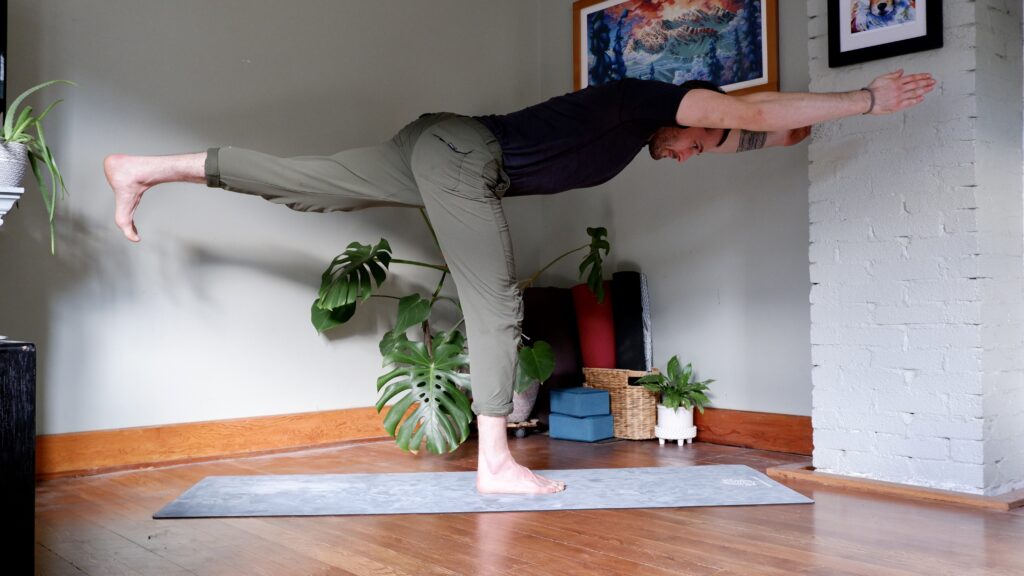
Commence in a High Lunge position with your right foot positioned forward. Join your palms together in a prayer position (Anjali Mudra) in front of your chest.
Gently bring together and elevate your pelvic floor muscles, followed by activating the lower abdominals by drawing in the lower belly, bringing the navel toward the spine. This action engages the Mula and Uddiyana Bandhas, providing stability and a sense of lightness.
Upon exhaling, hinge at the hips, lowering your upper body to approximately a 45-degree angle with the floor. Maintain focus on a point just in front of your mat as your drishti, or gazing point.
Inhale deeply, grounding firmly through the front foot, and initiate a forward shift of your weight. Simultaneously, lift the back foot from the floor.
Exhale, gradually straightening the standing leg as you align your body and left leg parallel to the floor. Lift the muscles of the right thigh to keep the leg engaged without locking the knee.
Flex the lifted foot, pointing the toes downward, and envision pressing the sole of the foot against an imaginary wall to sustain activation in the raised leg.
If possible, sustain the pose for five deep breaths, then bend the front knee, gently lower the back leg, and return to the High Lunge position.
Engaging in Warrior 3 targets the small muscles in the feet and ankles, as well as the core and muscles in the back. Maintaining a gentle bend in the knee contributes to balance and avoids locking the knee. It’s beneficial to visualize directing energy through the back foot to aid in lifting the leg. Proper execution involves ensuring level hips, an engaged core, and a neutral spine. Consistent practice of these principles in Warrior III can enhance performance in other balancing poses, such as Standing Splits.
Particularly effective for cultivating balance and body awareness. Try adding squats to this pose to really fire up the outer glutes and quad. Try 10 reps per leg and repeat 2-5 times. Lower slow and keep your hips square to the ground, stay long through the back leg and engage your core, aim to keep your back flat as you lower and rise.
This pose strengthens the majority lower body, enhances hip mobility to reduce the risk of soft-tissue injuries, and expands the range of motion for activities like kicking, squats, and directional changes. Goddess pose is suitable for both novice and advanced yogis.
The Utkata Konasana draws its name from Sanskrit, where “Utkata” signifies powerful or fierce, “Kona” translates to angle, and “Asana” means posture. Hence, the pose is also known as Fierce Angle Pose, emphasizing the intense representation of divine feminine energy. In yogic traditions, it is believed to trace its origins to the Hindu Goddess Kali, a manifestation of divine feminine energy, often depicted triumphantly in a distinctive squatting position. This has led to alternative names such as Horse Stance and Victory Squat Pose, or Deviasana/Kaliasana.
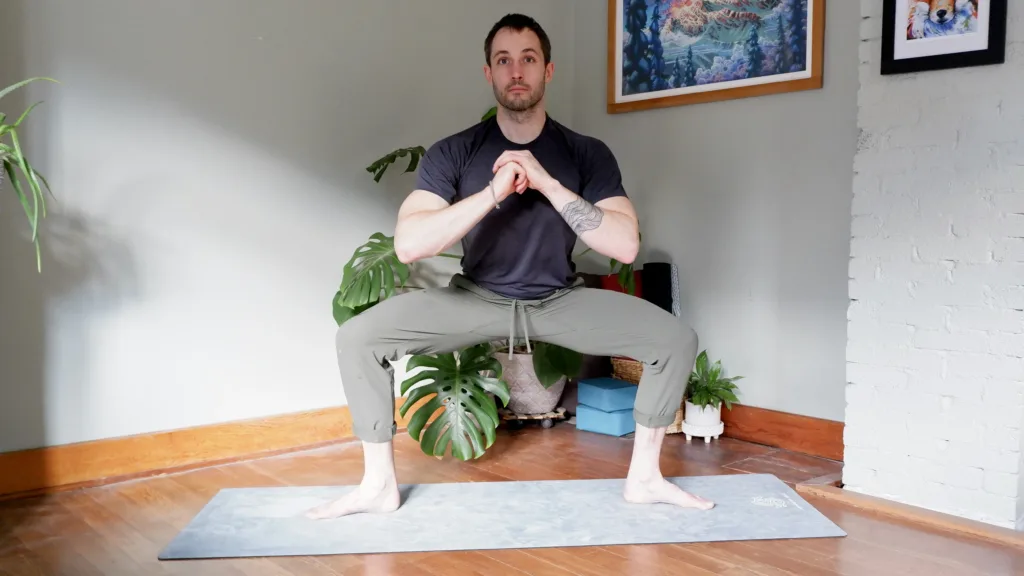
Stand with your feet positioned wider than the width of your shoulders. Ensure a sufficient distance between your feet, allowing for comfortable knee bending.
Turn your feet slightly outward, orienting your toes toward the corners of your mat.
Initiate a squatting motion by bending your knees.
Tuck your tailbone, lift and pull in your belly button, externally rotate your thighs, and straighten your spine while allowing your shoulders to relax.
Ensure that your knees stay aligned over your ankles as you continue to descend. If it feels comfortable, aim to bring your thighs to a parallel position with the floor.
Allow your arms to bend at the elbows or find an alternative comfortable resting position.
You can practice this both statically, holding the position for isometric strength training, or dynamically, incorporating movement similar to squats for a varied strength training and stretching experience. The inner thigh is an often neglected part of the leg so it’s common for tightness here to cause issues in other areas of the body such as the outer hips, lower back, and knees.
This pose can be used to ease those stiff, achy knees. Long days on the mountain can give your knees a good workout. Knees are a beautifully complex system of ligaments and tendons but because of this they are low in vascularity, meaning the tissue does not get great supplies of fresh blood as a muscle would, which means repairing and maintaining requires extra care and attention. Give your knees a little bit of TLC with hero pose. Try this after a hard day skiing or during your meditation practice. You can also rub massage oil or Epsom gel around the knees before this pose to assist in lowering inflammation and stiffness.
The term “Hero” in this context symbolizes individuals admired for their courage and ethical actions. Hero pertains to practitioners who, by engaging in the pose, strive to achieve a state of relaxation in both body and mind, overcoming inner turmoil. Regular and focused practice of this pose, free from distractions, has the potential to foster a connection with one’s spiritual side. Consequently, the pose has been incorporated into meditative yoga practices.
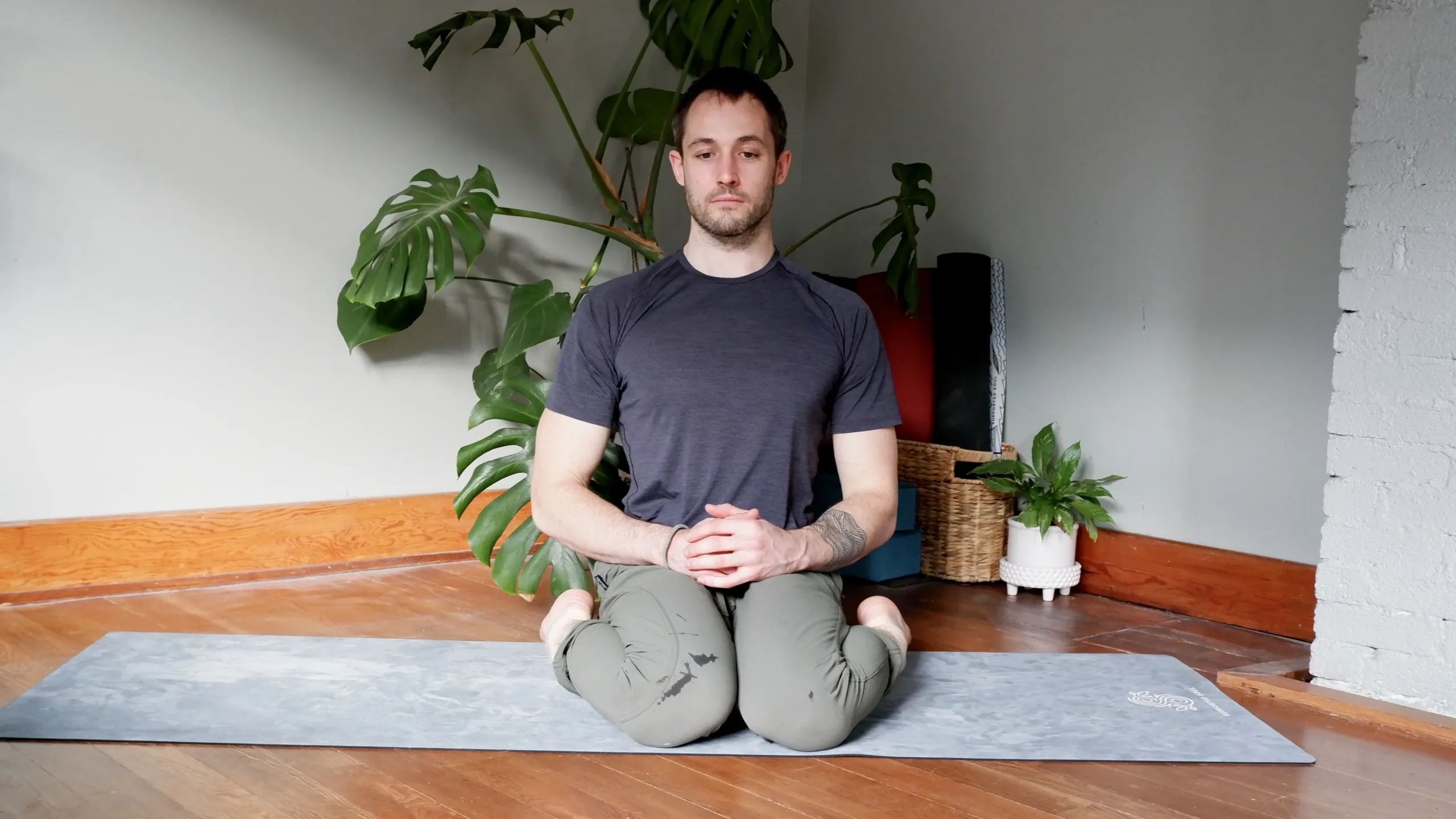


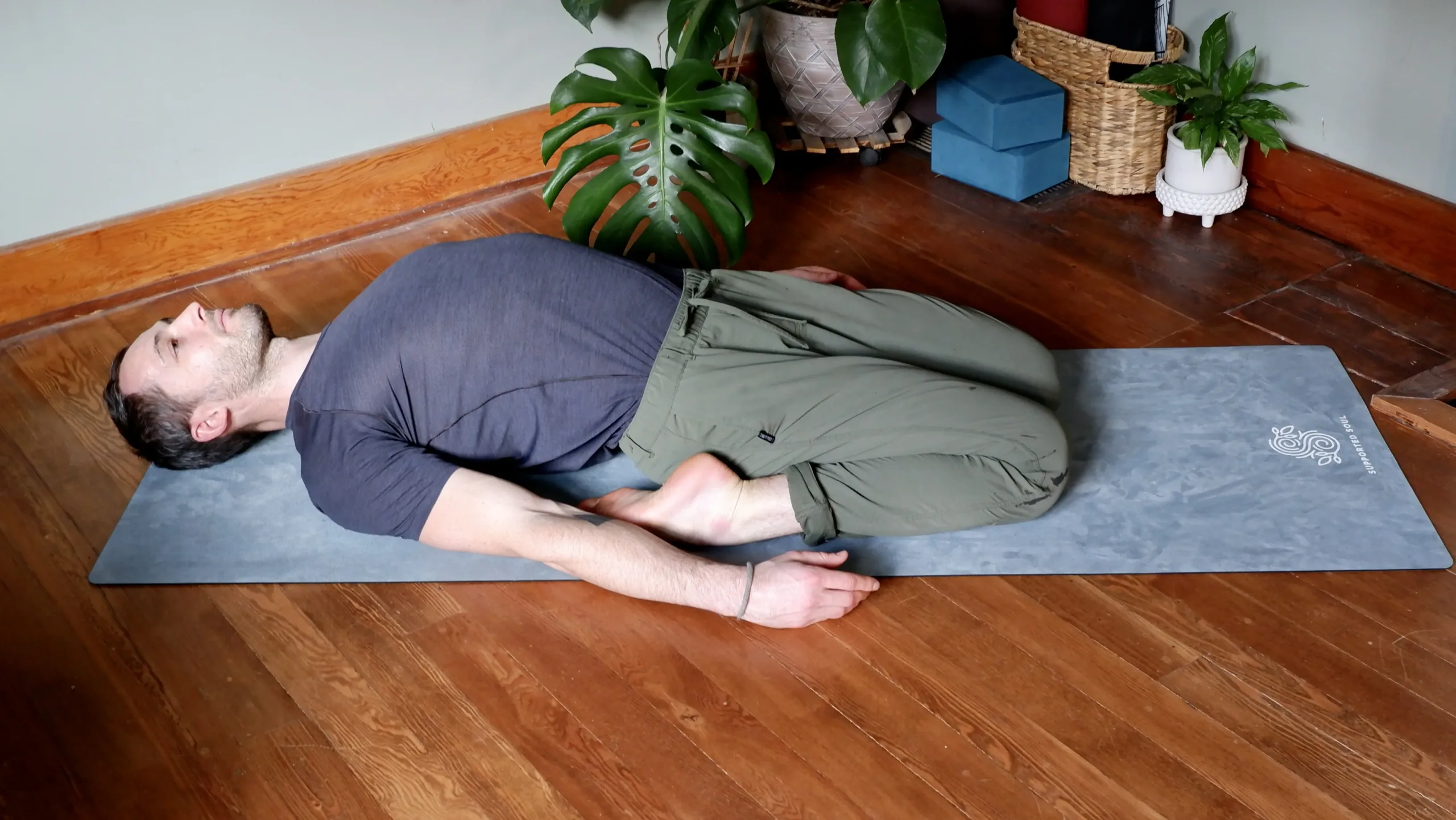


To transition into Hero pose or Virasana, start in a hands-and-knees position.
Bring your knees closer together and slightly widen your feet beyond hip distance.
Press the tops of your feet down and gradually lower your hips backward until you are seated on the mat (or props) between your heels.
Use your hands to move the flesh of your calves, engage your core by drawing the navel in and up, ground through your sitting bones, and lengthen through the crown of your head.
Hold the pose for 5 to 10 breaths.
To exit the pose, reverse the initial movements by placing your hands in front of you and lifting your hips back up to the hands-and-knees position.
Modify this by placing a block under the hips or keeping the knees apart. Increase the intensity in the quads by leaning back and bringing your elbows or upper back to the floor. Hold for around 10-20 slow, deep breaths.
The hip is an intricate structure, encompassing a ball-and-socket joint that connects the top of the leg to the pelvis. In addition to this joint, various muscle groups contribute to hip function, including the hip flexors (such as the psoas and rectus femoris), hip extensors (including the glutes and hamstrings), hip rotators (such as the piriformis and gluteus medius), and adductors (including the muscles of the groin). These muscles collaborate to support the pelvis, enabling the hip to move and generate force across multiple planes of motion. Weakness or imbalances within these structures can compromise performance, potentially leading to pain or injury due to inappropriate stress and strain.
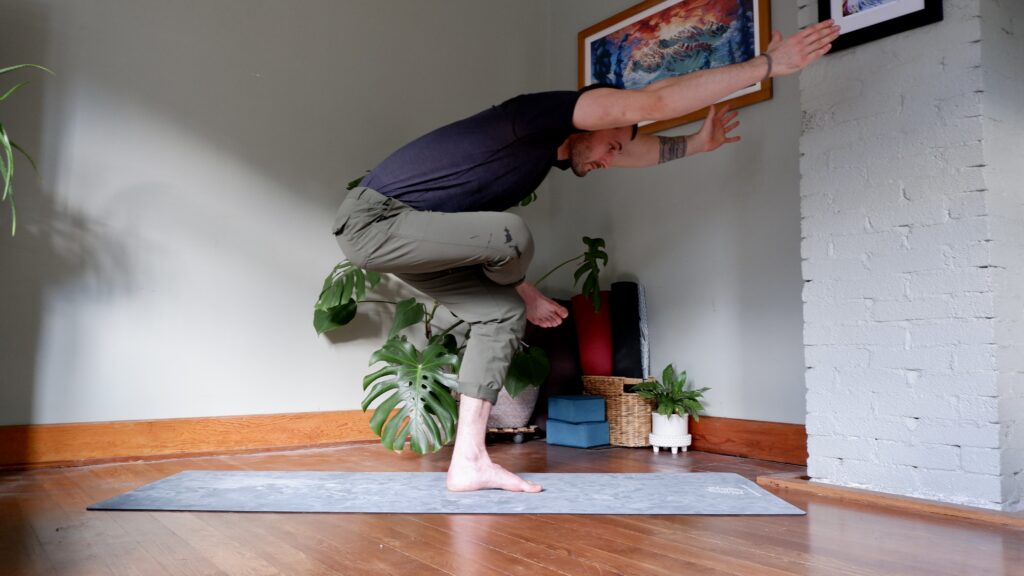
Stand in Mountain Pose Namaste (Pranamasana) and take a few breaths. Roll your shoulders back and forth to enhance flexibility.
Align your body, stand with an erect spine, relaxed shoulders, and chin parallel to the ground. Ensure a strong connection with the ground for your legs, with feet neatly aligned and straightened.
Palms should be joined in Namaskar Mudra Close Up (Anjali Mudra Close Up). Feel the strength in the calves, ankles, and hamstrings of your legs.
Inhale, maintaining Anjali Mudra Close Up with all four corners of the left foot firmly grounded. Lift the right leg and place the right foot on the left knee.
Be mindful, breathe steadily, and concentrate on sustaining balance. The secure grounding of all four corners of the left foot aids in maintaining equilibrium. Focus on a single point to ensure balance and advanced practitioners may opt to close their eyes if confident.
Remain in the pose for as long as possible, then release. Return to Pranamasana and take a few breaths.
Repeat the sequence with the right leg grounded and the left foot on the right knee.
Standing Pigeon Pose (Tada Kapotasana) serves as a moderate hip-opening posture, contributing to increased flexibility and stability in the pelvis. By enhancing stability in the pelvis and hips, the pose simultaneously strengthens the lower back, promoting greater agility and range of motion in the active joints and supporting muscles. Establishing robust legs and a stable lower back is crucial for improving the overall range of motion in the hips. This pose also aids in fortifying the feet. It is recommended to hold the pose for 3-5 breaths and repeat 2-3 times on each side. For a more soothing variation, particularly suitable before bedtime, consider the regular pigeon pose or reclined pigeon pose.
Sign up for our newsletter to receive the latest articles to guide your journey to a harmonious mind, body and spirit.
Follow along with us @sunadaliving